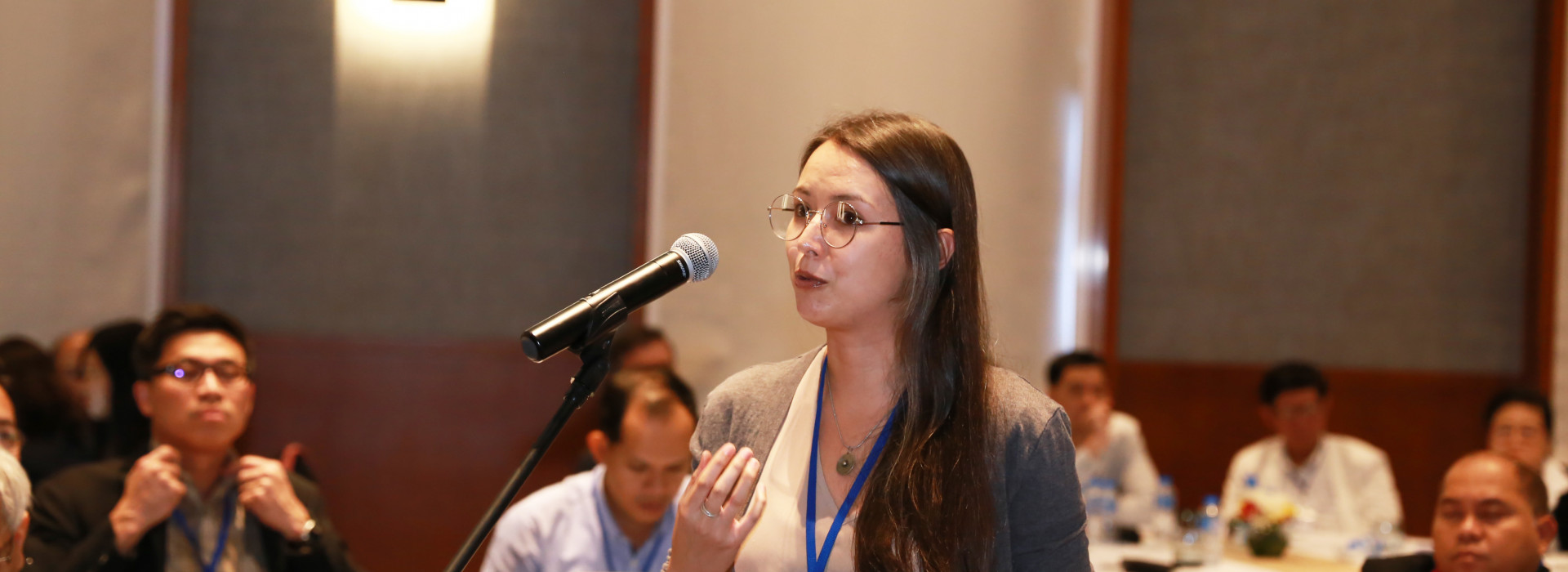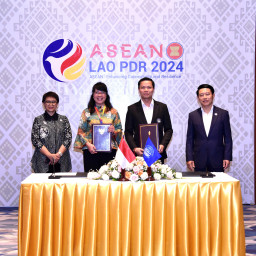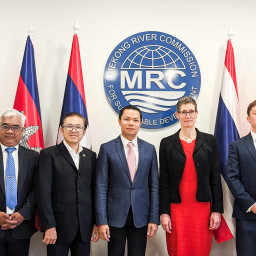Stakeholders continue debating Pak Lay project, offers a set of recommendations to improve it
Luang Prabang, Lao PDR, 17 January 2019 – More than 120 participants from various stakeholder groups gathered today in Luang Prabang to further debate the proposed Pak Lay hydropower project as the Mekong River Commission (MRC) convened the 2nd regional stakeholder session on the project, as part of its 6th Regional Stakeholder Forum. At the forum, they collectively made recommendations to make the project a more sustainable and environmentally friendly one.
“The Lao Government is open to constructive discussion and welcomes recommendations and suggestions that help improve the proposed project,” said Ms. Phakhavanh Phissamy, Deputy Director General at the Department of Natural Resources and Environmental Policy, as she opened the forum on behalf of the Lao Minister of Natural Resources and Environment. “The Government is willing to improve the project in the redesign and adaptive management when necessary.”
Ms. Phakhavanh Phissamy, Deputy Director General at the Department of Natural Resources and Environmental Policy, welcomes participants at the MRC stakeholder forum today.
The recommendations cover seven areas that the forum made following the discussion on findings from a second draft technical review report (TRR) prepared by the MRC Secretariat. The areas include sediment, hydrology, water quality, fisheries, socio-economic, navigation and dam safety issues of the proposed 770 MW Pak Lay hydropower project, the fourth project proposed on the lower Mekong mainstream.
For example, on sediment, the second draft TRR found that the project’s feasibility study is based on generally sound data sets that reflect the present conditions. Infrastructure and the management measures are consistent with those in good sediment practice.
It was, however, suggested that consideration should be given to larger sediment flushing gates, updating the modeling with better sediment data and better analysis of impacts on geomorphology.
On fisheries, it was found the current design would not be effective in passing migratory fish and that substantial improvement and investment are needed for the final detailed design.
Regarding socio-economic issues, the TRR found the assessment and compensation program for the most directly affected communities are consistent with international practice. But there are many outstanding concerns on transboundary impacts that need to be properly assessed.
As far as dam safety is concerned, the TRR found approaches to structural stability and safety monitoring as well as dam safety management system appear to be acceptable. But dam failure mode assessment is lacking. There was a recommendation to establish an independent panel of experts for dam safety purpose.
These recommendations and other suggestions were generally echoed by member countries who shared key recommendations from their national stakeholder consultations. The feedback and recommendations were recorded and will be included in the forum report, which will then be considered and reflected in the revised final draft TRR. The final draft TRR will be submitted to the MRC member countries, especially the proposing country, for their consideration and for possible inclusion in a joint statement and joint action plan, at the end of the six-month prior consultation process.
The current draft version of the TRR has also addressed comments from the stakeholders who made during the first regional stakeholder forum in September last year in Vientiane.
The MRC Secretariat’s incoming Chief Executive Officer Dr. An Pich Hatda said the Secretariat is committed to supporting the MRC member countries by providing sound technical review and facilitating discussion on the project so that necessary outcomes are borne out at the end of the prior consultation process.
“Before a statement and joint action plan for the Pak Lay hydropower project are out, it is vital that the joint action plan for the Pak Beng hydropower project is approved and released in order to demonstrate clear commitment to implement the statement by all parties,” Dr. An said.
MRC Secretariat’s incoming Chief Executive Officer Dr. An Pich Hatda addresses the participants as he closes the forum.
This is the fourth time the MRC has carried out the prior consultation under the Procedures for Notification, Prior Consultation and Agreement, including the 1,285 MW Xayaburi hydropower project, the Don Sahong hydropower project, a 240 MW dam, and the 912 MW Pak Beng hydropower project.
The prior consultation on the Pak Lay hydropower project officially began on 8 August 2018 and will run until late March 2019. By that time, the Joint Committee Working Group (JCWG), a technical advisory body of the MRC, will deliberate recommendations to be submitted to the MRC Joint Committee, a policy-implementing body consisting of representatives of MRC four member countries. The prior consultation process normally lasts six months but could be extended upon agreement by the Joint Committee.
In late February 2019, the JCWG will convene its third meeting to review and discuss the final draft TRR, discuss a summary of key recommendations and propose a statement on the proposed Pak Lay hydropower project.
Note to editors:
The MRC is an intergovernmental organization for regional dialogue and cooperation in the lower Mekong river basin, established in 1995 based on the Mekong Agreement between Cambodia, Lao PDR, Thailand and Viet Nam. The organization serves as a regional platform for water diplomacy as well as a knowledge hub of water resources management for the sustainable development of the region.
- END -





